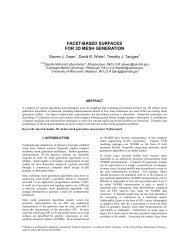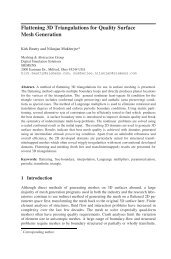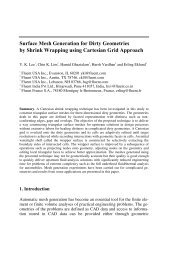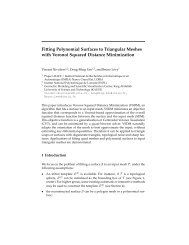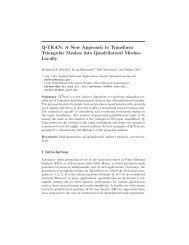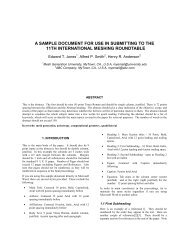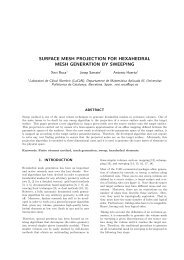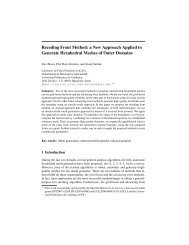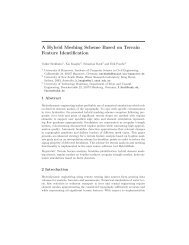CPU-GPU Algorithms for Triangular Surface Mesh Simplification
CPU-GPU Algorithms for Triangular Surface Mesh Simplification
CPU-GPU Algorithms for Triangular Surface Mesh Simplification
You also want an ePaper? Increase the reach of your titles
YUMPU automatically turns print PDFs into web optimized ePapers that Google loves.
<strong>CPU</strong>-<strong>GPU</strong> <strong>Algorithms</strong> <strong>for</strong> <strong>Triangular</strong> <strong>Surface</strong> <strong>Mesh</strong> <strong>Simplification</strong> 17order. Reordering the mesh elements as a preprocessing step would likelyminimize the repeated simplification of mesh elements in a given area. <strong>Mesh</strong>optimization may also be useful <strong>for</strong> improving the quality of the surface meshelements.It would also be interesting to implement a hybrid mesh simplificationalgorithm that takes advantage of the speed of the <strong>GPU</strong> inverse reductionalgorithm and the simplification rate of the <strong>GPU</strong> marking algorithm. Thiscould potentially increase the simplification rate as well as decrease the runningtime of the simplification algorithm. Further algorithmic speed may beaccomplished through the utilization of additional <strong>CPU</strong> cores or additional<strong>GPU</strong>s, which could take full advantage of parallelism. This may prove to be especiallyuseful <strong>for</strong> real-time graphics and scientific visualization applications.5 AcknowledgementsThe work of the first author is supported in part by NSF grants CNS-0720749and NSF CAREER Award OCI-1054459.References1. Y. Afek, E. Gafni, J. Tromp, and P. Vitany. Wait-free test-and-set. In AdrianSegall and Shmuel Zaks, editors, Distributed <strong>Algorithms</strong>, volume 647 of LectureNotes in Computer Science, pages 85–94. Springer Berlin / Heidelberg, 1992.2. AIM@SHAPE. Aim@shape shape repository 4.0, February 2012.http://shapes.aimatshape.net/.3. M.-E. Algorri and F. Schmitt. <strong>Mesh</strong> simplification. Computer Graphics Forum,15(3):77–86, 1996.4. C.L. Bajaj, V. Pascucci, and G. Zhuang. Progressive compression and transmissionof arbitrary triangular meshes. In Proc. Visualization ’99, Visualization’99, pages 307–537, 1999.5. D. Brodsky and J.B. Pedersen. A parallel framework <strong>for</strong> simplification of massivemeshes. In Proc. of the 2003 IEEE Symposium on Parallel and Large-DataVisualization and Graphics, PVG ’03, pages 17–24, Washington, DC, USA, 2003.IEEE Computer Society.6. P. Cignoni, C. Montani, and R. Scopigno. A comparison of mesh simplificationalgorithms. Computers & Graphics, 22:37–54, 1997.7. NVIDIA Corporation. CUDA Toolkit, January 2012.http://developer.nvidia.com/cuda-toolkit-41.8. C. DeCoro and N. Tatarchuk. Real-time mesh simplification using the <strong>GPU</strong>. InProc. of the 2007 Symposium on Interactive 3D Graphics and Games, I3D ’07,pages 161–166, New York, NY, USA, 2007. ACM.9. F. Dehne, C. Langis, and G. Roth. <strong>Mesh</strong> simplification in parallel. In ICA3PP’00, pages 281–290, 2000.10. C. Dick, J. Schneider, and R. Westermann. Efficient geometry compression <strong>for</strong><strong>GPU</strong>-based decoding in realtime terrain rendering. Computer Graphics Forum,28(1):67–83, 2009.



